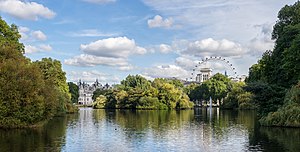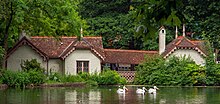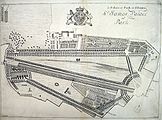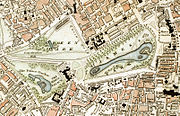Wikipedia
This text was copied from Wikipedia on 17 January 2025 at 5:10AM.
| St James's Park | |
|---|---|
 Looking east from the Blue Bridge towards Horse Guards | |
| Location | London, SW1 United Kingdom |
| Coordinates | 51°30′09″N 00°08′06″W / 51.50250°N 0.13500°W / 51.50250; -0.13500 |
| Area | 23 hectares (57 acres) |
| Established | 1603 |
| Operated by | The Royal Parks |
| Public transit access | St James's Park, Green Park, Victoria, and Westminster tube stations |
St James's Park is a 23-hectare (57-acre) urban park in the City of Westminster, central London. A Royal Park, it is at the southernmost end of the St James's area, which was named after a once isolated medieval hospital dedicated to St James the Less, now the site of St James's Palace. The area was initially enclosed for a deer park near the Palace of Whitehall for King Henry VIII in the 1530s. It is the most easterly of a near-continuous chain of public parks that includes (moving westward) Green Park, Hyde Park, and Kensington Gardens.[1][2][3]
The park is bounded by Buckingham Palace to the west, The Mall to the north, Horse Guards to the east, and Birdcage Walk to the south. It meets Green Park at Queen's Gardens with the Victoria Memorial at its centre, opposite the entrance to Buckingham Palace. St James's Palace is on the opposite side of The Mall. The closest London Underground stations are St James's Park, Green Park, Victoria, and Westminster.[2]
The park is Grade I listed on the Register of Historic Parks and Gardens.[4]
Features

The park has a small lake, St James's Park Lake, with two islands, West Island and Duck Island, the latter named for the lake's collection of waterfowl. At the end of the nineteenth century Duck Island was considered a sufficiently remote location for Scotland Yard to establish a bomb disposal facility there; the resident bird-keeper was given the responsibility of looking after the implements kept for dismantling the devices.[5] It now houses pumps and water treatment machinery for the lake and fountains.[6]
A resident colony of pelicans has been a feature of the park since a Russian ambassador donated them to Charles II in 1664.[7] While most of the birds' wings are clipped, there is a pelican which can be seen flying, occasionally beyond the confines of the Park.[8]
The Blue Bridge across the lake affords a tree-framed view west towards Buckingham Palace. Looking east, the view includes the Swire Fountain to the north of Duck Island and, past the lake, the grounds of Horse Guards Parade, with Horse Guards, the Old War Office and Whitehall Court behind. To the south of Duck Island is the Tiffany Fountain on Pelican Rock; and past the lake is the Foreign, Commonwealth and Development Office, with the London Eye, the Shell Tower, and the Shard behind.[2] The park has a children's playground including a large sandpit.[9]
The species of trees in the park include London planes, Scarlet oak, black mulberry, and a fig tree.[10]
History
In 1532, Henry VIII purchased from Eton College an area of marshland through which the Tyburn flowed. It lay to the west of York Place acquired by Henry from Cardinal Wolsey; it was purchased in order to turn York Place, subsequently renamed Whitehall, into a dwelling fit for a king. Henry enclosed the park for deer hunting and built St James Palace to initially serve as his hunting lodge. On James I's accession to the throne in 1603, he ordered that the park be drained and landscaped, and exotic animals were kept in the park, including camels, crocodiles, an elephant and exotic birds, kept in aviaries.[11]
While Charles II was in exile in France under the Commonwealth of England, he was impressed by the elaborate gardens at French royal palaces, and on his ascension he had the park redesigned in a more formal style, probably by the French landscaper André Mollet. A 775-metre by 38-metre (850 by 42-yard) ornamental canal was created as evidenced in the old plan. The king opened the park to the public and used the area to entertain guests and mistresses, such as Nell Gwyn. The park became notorious at the time as a meeting place for impromptu acts of lechery, as described by John Wilmot, 2nd Earl of Rochester in his poem "A Ramble in St James's Park".[12]
In the late 17th and early 18th centuries cows grazed on the park, and milk could be bought fresh at the "Lactarian", described by Zacharias Conrad von Uffenbach in 1710.[13] The 18th century saw further changes, including the reclamation of part of the canal for Horse Guards Parade and the purchase of Buckingham House (now Buckingham Palace) at the west end of the Mall, for the use of Queen Charlotte in 1761.

Further remodelling in 1826–27, commissioned by the Prince Regent (later George IV) and overseen by the architect and landscaper John Nash, saw the canal's conversion into a more naturally-shaped lake, and formal avenues rerouted to romantic winding pathways. At the same time, Buckingham House was expanded to create the palace, and Marble Arch was built at its entrance, whilst The Mall was turned into a grand processional route. It opened to public traffic 60 years later in 1887. The arch was moved to its current location at the junction of Oxford Street and Park Lane in 1851 and the Victoria Memorial was erected between 1906 and 1911.[14][15]
Gallery
-
André Mollet's design for the park in Charles II's time, before 18th and 19th century remodelling, which shaped a more natural-looking lake from the straight canal visible here, the eastern part of which was filled in to create Horse Guards Parade
-
Fashionable people thronging St James's Park, c.1745
-
Green Park and St James's Park c.1833
-
Duck Island Cottage
-
St James's Park Lake, looking northwest, with Buckingham Palace in the background
References
- ^ "St James's Park". Royal Parks. Retrieved 30 November 2014.
- ^ a b c "Map of St James's Park". Royal Parks. Retrieved 1 June 2015.
- ^ "History and Architecture of St James's Park". Royal Parks. Retrieved 1 June 2015.
- ^ Historic England, "St James's Park (1000483)", National Heritage List for England, retrieved 11 July 2017
- ^ Jensen, Richard Bach (2014). The battle against anarchist terrorism : an international history, 1878-1934. Cambridge University Press. pp. 128–9. ISBN 978-1-107-03405-1.
- ^ "Duck Island St James's Park". The Royal Parks. Retrieved 9 September 2022.
- ^ "Pelicans". The Royal Parks.
- ^ "Royal park resident turns nasty and eats neighbour". The Independent. 12 June 1999. Archived from the original on 24 May 2022.
- ^ "10 of the best parks with playgrounds in Westminster".
- ^ "Trees". The Royal Parks. Retrieved 31 March 2023.
- ^ "St James's Park – From pigs to processions". The Royal Parks. Retrieved 18 February 2014.
- ^ Rochester. "A Ramble in St. James's Park".
- ^ Cockayne, Emily (2007). Hubbub: Filth Noise & Stench in England. Yale University Press. p. 100. ISBN 978-0-300-13756-9.
- ^ "The Marble Arch, Marble Arch W1". Historic England. Retrieved 28 December 2023.
- ^ "Queen Victoria Memorial, The Mall SW1". Historic England. Retrieved 28 December 2023.
External links
 Media related to St. James's Park at Wikimedia Commons
Media related to St. James's Park at Wikimedia Commons- Visitor information at the Royal Parks website








12 Annotations
First Reading
language hat • Link
From the Companion:
St. James's Park. Formed and walled in by Henry VIII, transformed by Charles II and much modified by George IV. The diary has many references to its use by the King and his circle, to the degree of semi-privacy preserved there, and to the great alterations in its lay-out made in the '60s, but no set of plans of those alterations has yet appeared. It contained at this time a lake and canal, a physic garden and several deer-houses.
Glyn • Link
St James Park was next to St James Palace (now long-gone) and very near to Pepys' office.
Although there were still open fields nearby, parks were less common. This map shows buildings were beginning to grow around it:
http://instruct.uwo.ca/english/23…
And this map from about 80 years later, show the Park after its alterations by King Charles 2nd:
http://www.motco.com/Map/81002/Se…
You will find these and other maps at "BACKGROUND INFORMATION / GENERAL REFERENCE / MAPS / MAPS OF LONDON"
vincent • Link
St James Park and rest of city 173?
"....St. James's Park is something more than a mile in circumference, and
the form pretty near oval; about the middle of it runs a canal 2,800
feet in length and 100 in breadth, and near it are several other
waters, which form an island that has good cover for the breeding
and harbouring wild ducks and other water-fowl; on the island also
is a pretty house and garden, scarce visible to the company in the
park..... the shining equipage of the soldiery, will find their eyes and ears agreeably entertained by the
horse ..."
london 1731 written 17xx Don Manoel Gonzales
http://www.flora-source.com/libra…
Also pages of description of London town . A regular tour guide for "Toute de mondo popoli including the commutors rushing from black fryers ste" It may be 70 years later. London of the 1940's is closer to SP than changes that have come to be 'til now (the 21st c), since first I went prancing down the mall to Buck. Pal.
paul galpin • Link
St. James's Palace (now long-gone)
Glyn is somewhat precipitate to describe St. James's Palace thus, since it still stands, close to St. James's Park, sandwiched between The Mall and Pall Mall - where it can be seen on the second map referenced by Glyn.
The Palace remains a Royal Residence as well as housing some of the offices of the Royal Household. Further information about the Palace can be found at http://www.royal.gov.uk/output/pa…
Brian McMullen • Link
Two links about Birdcage Walk and the Decoy during the reign of Charles II
http://myweb.tiscali.co.uk/london…
http://www.decoymans.co.uk/chapte…
Ruben • Link
the official site of the Park with some history of the birds and a passport picture of a Pelican.
see: http://www.angelfire.com/in/uktra…
dirk • Link
A contemporary anecdote...
"It was [...] in St. James's Park the Duke of York, meeting John Milton one day, asked him if his blindness was not to be regarded as a just punishment from heaven, due to his having written against the martyred king. "If so, sir," replied the great poet and staunch republican, "what must we think of his majesty's execution upon a scaffold?" To which question his royal highness vouchsafed no reply."
From:
"Royalty Restored or London under Charles II", ch.XIX
http://www.worldwideschool.org/li…
Michael Robinson • Link
Dankerts, Henrik (Dutch c.1625-1680)
Whitehall and Westminster from St James's Park; view looking E along the Park with the Mall left and the canal right, in the distance from left to right, Northumberland House, the houses bordering on Whitehall, Wallingford House, the Banqueting House, Holbein's Gate, the Cockpit, the Clock Tower, the West gate of New Palace Yard, Westminster Hall, St Margaret's, Westminster and the Abbey, in the mid-distance towards the left a tall post or maypole with a group of figures to the left
Pen and brown ink, with grey wash and watercolour; on three conjoined sheets with two strips interpolated
Executed, after c. 1662
http://www.britishmuseum.org/rese…
Michael Robinson • Link
Dankerts, Henrik (Dutch c.1625-1680)
St James's Park from the NE; view of the park seen from the eastern end of the canal and looking directly along it towards a distant building, probably Tart Hall, in the foreground three statues of classical figures, the central one representing a gladiator, along both sides of the canal, rows of young trees forming avenues running outwards diagonally, on the extreme left beyond a wall with a gateway, a double-gabled house with balcony and to its right other buildings, to the right a maypole (?) and beyond it the Mall visible through an avenue of taller trees
Pen and brown ink, over graphite, with grey, brown and blue-green wash; on two conjoined sheets
Executed, after c. 1662
http://www.britishmuseum.org/rese…
Pedro • Link
The Canada Goose
The Canada goose is a native of the American Atlantic seaboard, and records purport it to have been introduced to England by King Charles II (or more likely a collector), around 1660, having acquired a number of birds as additions to his wildfowl collection in St James's Park, London. Due to this Royal connection it soon became popular in country gardens with lakes and ponds across England, especially due to its striking plumage and call. It became a wildfowl staple with landed gentry and country estates. Surprisingly, despite its popularity, the first recorded entry for breeding does not occur until 1890. However, this may be the first wild breeding record, rather than captive. The records do not give a distinction. The Canada goose has taken 200 years to spread nationally, via escapees, released birds and possibly human intervention (see pest control below), in the wild and become acknowledged on the British list as a native bird1.
http://www.bbc.co.uk/dna/h2g2/A14…
Second Reading
Bill • Link
James's (St.) Park, a park of 58 1/2 acres (shaped not unlike a boy's kite), originally appertaining to the Palace of St James's. It was first formed and walled in by Henry VIII., replanted and beautified by Charles II.
...
Charles II threw the several ponds (Rosamond's Pond excepted) into one artificial canal, built a decoy for ducks, a small ring fence for deer, planted trees in even ranks, and introduced broad gravel walks in place of narrow and winding footpaths. Well might Dr King exclaim:
"The fate of things lies always in the dark;
What Cavalier would know St James's Park?
For Locket stands where gardens once did spring
And wild ducks quack where grasshoppers did sing."
...
Waller describes in pretty if somewhat languid and diffuse verse his vision of the charms of completed St James's, -- the groves with lovers walking in their amorous shade; the gallants dancing by the river's side, where they bathe in summer and in winter slide; the crystal lake in which a shoal of silver fishes glide, while laden anglers make the fishes and the men their prize.
---London, Past and Present. H.B. Wheatley, 1891.
Bill • Link
London: the Old Horse Guards from St James's Park. Canaletto, 1749.
http://www.wikipaintings.org/en/c…